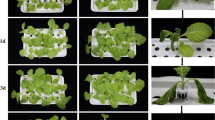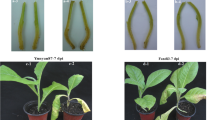Abstract
Bacterial wilt (BW) caused by Ralstonia solanacearum (Ras) is a very destructive disease in solanaceous crops. The molecular mechanism underlying BW resistance in solanaceous plants is still unclear. Using RNA sequencing, we investigated the transcriptional response in the seedling roots of a BW-resistant cultivar D101 and a BW-susceptible cultivar Changbohuang (CBH) of tobacco at 3 h after inoculation with Ras. In total, 158 and 835 differentially expressed genes (DEGs) were detected in D101 and CBH, respectively. Only 41 DEGs were in common between the two cultivars. The number of DEGs in D101 was much smaller than that in CBH, suggesting that D101 was less affected by the inoculation than CBH because of its higher resistance, which could be expressed at the early stages of Ras infection. Transcriptome analysis revealed that in D101 two sets of upregulated genes were significantly enriched in two corresponding groups of gene ontology terms regarding glutathione and flavonoids metabolisms, respectively, suggesting that glutathione and flavonoids are probably two types of main substances conferring the early resistance against Ras infection in tobacco root. Our findings provide a valuable clue to deeply investigate the molecular mechanism of BW resistance in tobacco and solanaceous plants.



Similar content being viewed by others
References
Alexa, A., & Rahnenfuhrer, J. (2017). topGO: Enrichment Analysis for Gene Ontology. Version 2.28.0. http://bioconductor.org/packages/release/bioc/html/topGO.html. Accessed 15 Aug 2017.
Alvarez, B., Biosca, E. G., & López, M. M. (2010). On the life of Ralstonia solanacearum, a destructive bacterial plant pathogen. In A. Mendez-Vilas (Ed.), Current research, technology and education topics in applied microbiology and microbial biotechnology (pp. 267–279). Badajoz: Formatex Research Center.
Bakshi, M., & Oelmüller, R. (2014). WRKY transcription factors: Jack of many trades in plants. Plant Signaling & Behavior, 9(2), e27700.
Cai, H., Yang, S., Yan, Y., Xiao, Z., Cheng, J., Wu, J., Qiu, A., Lai, Y., Mou, S., Guan, D., Huang, R., & He, S. (2015). CaWRKY6 transcriptionally activates CaWRKY40, regulates Ralstonia solanacearum resistance, and confers hightemperature and high-humidity tolerance in pepper. Journal of Experimental Botany, 66(11), 3163–3174.
Caldwell, D., Kim, B.-S., & Iyer-Pascuzzi, A. S. (2017). Ralstonia solanacearum differentially colonizes roots of resistant and susceptible tomato plants. Phytopathology, 107(5), 528–536.
Chen, N., Yu, B., Dong, R., Lei, J., Chen, C., & Cao, B. (2018). RNA-Seq-derived identification of differential expression in the eggplant (Solanum melongena) following inoculation with bacterial wilt. Gene, 644, 137–147.
Cobbett, C. S., May, M. J., Howden, R., & Rolls, B. (1998). The glutathione-deficient, cadmium-sensitive mutant, cad2-1, of Arabidopsis thaliana is deficient in gamma-glutamylcysteine synthetase. Plant Journal, 16(1), 73–78.
Conesa, A., Götz, S., García-Gómez, J. M., Terol, J., Talón, M., & Robles, M. (2005). Blast2GO: a universal tool for annotation, visualization and analysis in functional genomics research. Bioinformatics, 21(18), 3674–3676.
Danesh, D., Aarons, S., McGill, G. E., & Young, N. D. (1994). Genetic dissection of oligogenic resistance to bacterial wilt in tomato. Molecular Plant-Microbe Interactions, 7(4), 464–471.
Dang, F.-F., Wang, Y.-N., Yu, L., Eulgem, T., Lai, Y., Liu, Z.-Q., Wang, X., Qiu, A.-L., Zhang, T.-X., Lin, J., Chen, Y.-S., Guan, D.-Y., Cai, H.-Y., Mou, S.-L., & He, S.-L. (2013). CaWRKY40, a WRKY protein of pepper, plays an important role in the regulation of tolerance to heat stress and resistance to Ralstonia solanacearum infection. Plant, Cell and Environment, 36(4), 757–774.
Dean, J. D., Goodwin, P. H., & Hsiang, T. (2005). Induction of glutathione S-transferase genes of Nicotiana benthamiana following infection by Colletotrichum destructivum and C. orbiculare and involvement of one in resistance. Journal of Experimental Botany, 56(416), 1525–1533.
Dubreuil-Maurizi, C., & Poinssot, B. (2012). Role of glutathione in plant signaling under biotic stress. Plant Signaling & Behavior, 7(2), 210–212.
Ferreyra, M. L. F., Rius, S. P., & Casati, P. (2012). Flavonoids: biosynthesis, biological functions, and biotechnological applications. Frontiers in Plant Science, 3, a222.
Fofana, B., Benhamou, N., McNally, D. J., Labbé, C., Séguin, A., & Bélanger, R. R. (2005). Suppression of induced resistance in cucumber through disruption of the flavonoid pathway. Phytopathology, 95(1), 114–123.
French, E., Kim, B.-S., Rivera-Zuluaga, K., & Iyer-Pascuzzi, A. S. (2018). Whole root transcriptomic analysis suggests a role for auxin pathways in resistance to Ralstonia solanacearum in tomato. Molecular Plant-Microbe Interactions, 31(4), 432–444.
Grimault, V., & Prior, P. (1993). Bacterial wilt resistance in tomato associated with tolerance of vascular tissues to Pseudomonas solanacearum. Plant Pathology, 42(4), 589–594.
Gullner, G., & Kômíves, T. (2006). Defense reactions of infected plants: roles of glutathione and glutathione S-transferase enzymes. Acta Phytopathologica et Entomologica Hungarica, 41(1–2), 3–10.
Higashi, K., Ishiga, Y., Inagaki, Y., Toyoda, K., Shiraishi, T., & Ichinose, Y. (2008). Modulation of defense signal transduction by Xagellin-induced WRKY41 transcription factor in Arabidopsis thaliana. Molecular Genetics and Genomics, 279(3), 303–312.
Hu, Y., Dong, Q., & Yu, D. (2012). Arabidopsis WRKY46 coordinates with WRKY70 and WRKY53 in basal resistance against pathogen Pseudomonas syringae. Plant Science, 185-186, 288–297.
Huet, G. (2014). Breeding for resistances to Ralstonia solanacearum. Frontiers in Plant Science, 5(715), 1–5.
Hwang, J., Choi, Y., Kang, J., Kim, S., Cho, M., Mihalte, L., & Park, Y. (2011). Microarray analysis of the transcriptome for bacterial wilt resistance in pepper (Capsicum annuum L.). Notulae Botanicae Horti Agrobotanici Cluj-Napoca, 39(2), 49–57.
Ishihara, T., Mitsuhara, I., Takahashi, H., & Nakaho, K. (2012). Transcriptome analysis of quantitative resistance-specific response upon Ralstonia solanacearum infection in tomato. PLoS ONE, 7(10), e46763.
Jones, J. D. G., & Dangl, J. L. (2006). The plant immune system. Nature, 444(16), 323–329.
Kim, D., Langmead, B., & Salzberg, S. L. (2015). HISAT: a fast spliced aligner with low memory requirements. Nature Methods, 12(4), 357–360.
Knoth, C., Ringler, J., Dangl, J. L., & Eulgem, T. (2007). Arabidopsis WRKY70 is required for full RPP4-mediated disease resistance and basal defense against Hyaloperonospora parasitica. Molecular Plant-Microbe Interactions, 20(2), 120–128.
Kumar, S., & Pandey, A. K. (2013). Chemistry and biological activities of flavonoids: an overview. Scientific World Journal, 2013, a162750.
Lan, T., Zheng, S., Yang, L., Wang, B., Zhang, S., Tong, Z., Chen, Y., Chen, S., Duan, Y., & Wu, W. (2014). Mapping of quantitative trait loci conferring resistance to bacterial wilt in tobacco (Nicotiana tabacum L.). Plant Breeding, 133(5), 672–677.
Le Roux, C., Huet, G., Jauneau, A., Camborde, L., Trémousaygue, D., Kraut, A., Zhou, B., Levaillant, M., Adachi, H., Yoshioka, H., Raffaele, S., Berthomé, R., Couté, Y., Parker, J. E., & Deslandes, L. (2015). A receptor pair with an integrated decoy converts pathogen disabling of transcription factors to immunity. Cell, 161(5), 1074–1088.
Margin, B., Thouqet, P., Olivier, J., & Grimsley, N. H. (1999). Temporal and multiple quantitative trait loci analysis of resistance to bacterial wilt in tomato permit resolution of linked loci. Genetics, 151(3), 1165–1172.
Mierziak, J., Kostyn, K., & Kulma, A. (2014). Flavonoids as important molecules of plant interactions with the environment. Molecules, 19(10), 16240–16265.
Mimura, Y., Kageyama, T., Minamiyama, Y., & Hirai, M. (2009). QTL analysis for resistance to Ralstonia solanacearum in Capsicum accession ‘LS2341’. Journal of the Japanese Society for Horticultural Science, 78(3), 307–313.
Mukhtar, M. S., Deslandes, L., Auriac, M.-C., Marco, Y., & Somssich, I. E. (2008). The Arabidopsis transcription factor WRKY27 influences wilt disease symptom development caused by Ralstonia solanacearum. Plant Journal, 56(6), 935–947.
Parisy, V., Poinssot, B., Owsianowski, L., Buchala, A., Glazebrook, J., & Mauch, F. (2007). Identification of PAD2 as a gamma-glutamylcysteine synthetase highlights the importance of glutathione in disease resistance of Arabidopsis. Plant Journal, 49(1), 159–172.
Poueymiro, M., & Genin, S. (2009). Secreted proteins from Ralstonia solanacearum: a hundred tricks to kill a plant. Current Opinion in Microbiology, 12(1), 44–52.
Qian, Y., Wang, X., Wang, D., Zhang, L., Zu, C., Gao, Z., & Zhang, H. (2013). The detection of QTLs controlling bacterial wilt resistance in tobacco (N. tabacum L.). Euphytica, 192(2), 259–266.
Robinson, M. D., McCarthy, D. J., & Smyth, G. K. (2010). edgeR: a Bioconductor package for differential expression analysis of digital gene expression data. Bioinformatics, 26(1), 139–140.
Schön, M., Töller, A., Diezel, C., Roth, C., Westphal, L., Wiermer, M., & Somssich, I. C. (2013). Analyses of wrky18 wrky40 plants reveal critical roles of SA/EDS1 signaling and indole-glucosinolate biosynthesis for Golovinomyces orontii resistance and a loss of resistance towards Pseudomonas syringae pv. tomato AvrRPS4. Molecular Plant-Microbe Interactions, 26(7), 758–767.
Thomma, B. P., Nurnberger, T., & Joosten, M. H. (2011). Of PAMPs and effectors: the blurred PTI-ETI dichotomy. Plant Cell, 23(1), 4–15.
Thoquet, P., Olivier, J., Sperisen, C., Rogowsky, P., Laterrot, H., & Grimsley, N. (1996a). Quantitative trait loci determining resistance to bacterial wilt in tomato cultivar Hawaii7996. Molecular Plant-Microbe Interactions, 9(9), 826–836.
Thoquet, P., Olivier, J., Sperisen, C., Rogowsky, P., Prior, P., Anaïs, G., Mangin, B., Bazin, B., Nazer, R., & Grimsley, N. (1996b). Polygenic resistance of tomato plants to bacterial wilt in the French West Indies. Molecular Plant-Microbe Interactions, 9(9), 837–842.
Trapnell, C., Williams, B. A., Pertea, G., Mortazavi, A., Kwan, G., van Baren, M. J., Salzberg, S. L., Wold, B. J., & Pachter, L. (2010). Transcript assembly and quantification by RNA-Seq reveals unannotated transcripts and isoform switching during cell differentiation. Nature Biotechnology, 28(5), 511–515.
Vasse, J., Danoun, S., & Trigalet, A. (2005). Microscopic studies of root infection in resistant tomato cultivar Hawaii 7996. In C. Allen, P. Prior, & A. C. Hayward (Eds.), Bacterial wilt disease and the Ralstonia solanacearum species complex (p. 285). St. Paul: APS Press.
Wang, Y., Dang, F., Liu, Z., Wang, X., Eulgem, T., Lai, Y., Yu, L., She, J., Shi, Y., Lin, J., Chen, C., Guan, D., Qiu, A., & He, S. (2013). CaWRKY58, encoding a group I WRKY transcription factor of Capsicum annuum, negatively regulates resistance to Ralstonia solanacearum infection. Molecular Plant Pathology, 14(2), 131–144.
Yabuuchi, E., Kosako, Y., Oyaizu, H., Yano, I., Hotta, H., Hashimoto, Y., Ezaki, T., Arakawa, M. (1992). Proposal of Burkholderia gen. nov. and transfer of seven species of the genus Pseudomonas homology group II to the new genus, with the type species Burkholderia cepacia (Palleroni and Holmes 1981) comb. nov. Microbiology and Immunology, 36(12), 1251–1275.
Zuluaga, A. P., Solé, M., Lu, H., Góngora-Castillo, E., Vaillancourt, B., Coll, N., Robin Buell, C., & Valls, M. (2015). Transcriptome responses to Ralstonia solanacearum infection in the roots of the wild potato Solanum commersonii. BMC Genomics, 16, 246.
Author information
Authors and Affiliations
Corresponding author
Ethics declarations
The paper has not been submitted elsewhere for publication, in whole or in part.
Conflict of interests
The authors declare that there is no conflict of interests regarding the publication of this paper.
Human and animal studies
The research did not involve any human participants and/or animals.
Informed consent
Informed consent was obtained from all individual participants included in this study.
Rights and permissions
About this article
Cite this article
Gao, W., Chen, R., Pan, M. et al. Early transcriptional response of seedling roots to Ralstonia solanacearum in tobacco (Nicotiana tabacum L.). Eur J Plant Pathol 155, 527–536 (2019). https://doi.org/10.1007/s10658-019-01788-x
Accepted:
Published:
Issue Date:
DOI: https://doi.org/10.1007/s10658-019-01788-x




